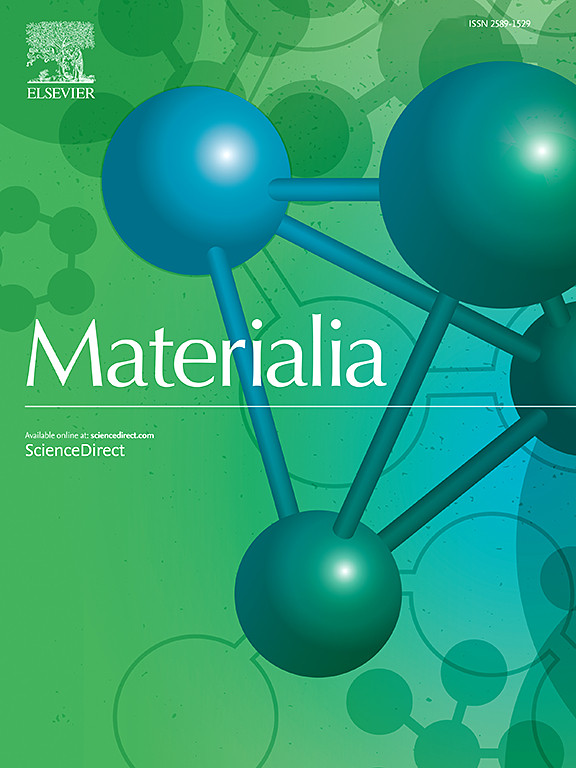增材制造Ti-6Al-4V中的滑移与双马氏体:晶界视角
IF 2.9
Q2 MATERIALS SCIENCE, MULTIDISCIPLINARY
引用次数: 0
摘要
关于Ti合金中的马氏体相变是由滑移机制还是双基机制控制的,一直存在争论。占主导地位的机理取决于由组成引起的晶格参数变化。例如,CP-Ti通常发生滑移基转变,而Ti-6Al-4V倾向于双基转变。然而,加工条件,特别是在增材制造(AM)中,可以引入晶格应变和改变晶格参数,导致不同的马氏体转变机制。这两种机制都影响变异选择和特征变异簇形态的形成,如三角形(基于滑动)和v形(基于双胞胎),这反过来又决定了变异边界的选择(IBs)。本研究探讨了Ti-6Al-4V中IBs的特性和网络,用于两种不同的AM工艺:激光粉末床熔合(L-PBF)和线激光直接能量沉积(L-DED)。变异选择的同情方法被扩展到IB和双胞胎边界的选择。研究了晶界网络的关键特征,包括三重点和二面角,以更深入地了解晶界网络的稳定性、结构和与变异选择机制的相关性。结果表明,L-DED中以v型簇为主,而L-PBF中以三角形簇为主。此外,L-DED比L-PBF样品抑制了更高比例的Σ13b孪晶界。这些发现表明,L-DED的马氏体转变主要是基于双晶的,而L-PBF的马氏体转变更可能是基于滑移的。共感方法对Ti合金中的马氏体相变机制提供了有价值的见解。本文章由计算机程序翻译,如有差异,请以英文原文为准。

Slip vs. Twin martensite in additively manufactured Ti-6Al-4V: A grain boundary perspective
There is an ongoing debate regarding whether martensitic transformation in Ti alloys is governed by slip or twin-based mechanisms. The mechanism that predominates depends on lattice parameter changes caused by composition. For instance, CP-Ti typically under- goes slip-based transformation, while Ti-6Al-4V tends to favor twin-based transformation. However, processing conditions, particularly in additive manufacturing (AM), can introduce lattice strains and alter lattice parameters, resulting in distinct martensitic transformation mechanisms. Both mechanisms influence the variant selection and the formation of character- istic variant cluster morphologies, such as triangular (slip-based) and V-shaped (twin-based), which in turn dictate the selection of intervariant boundaries (IBs). This study explores the characteristics and network of IBs in Ti-6Al-4V for two distinct AM processes: Laser-Powder Bed Fusion (L-PBF) and Wire Laser-Direct Energy Deposition (L-DED). The sympathetic approach to variant selection is extended to the selection of IB and twin boundaries. Key features of the IB network, including triple points and dihedral angles, are examined to pro- vide a deeper understanding of the stability, configuration, and correlation of grain boundary networks with variant selection mechanisms. It is observed that V-shaped clusters dominate in L-DED, while triangular clusters are more common in L-PBF. Furthermore, L-DED ex- hibits a higher fraction of Σ13b twin boundaries than L-PBF samples. These findings suggest that martensitic transformation in L-DED is primarily twin-based, whereas in L-PBF, it is more likely to be slip-based. The sympathetic approach provides valuable insights into the martensitic transformation mechanisms in Ti alloys.
求助全文
通过发布文献求助,成功后即可免费获取论文全文。
去求助
来源期刊

Materialia
MATERIALS SCIENCE, MULTIDISCIPLINARY-
CiteScore
6.40
自引率
2.90%
发文量
345
审稿时长
36 days
期刊介绍:
Materialia is a multidisciplinary journal of materials science and engineering that publishes original peer-reviewed research articles. Articles in Materialia advance the understanding of the relationship between processing, structure, property, and function of materials.
Materialia publishes full-length research articles, review articles, and letters (short communications). In addition to receiving direct submissions, Materialia also accepts transfers from Acta Materialia, Inc. partner journals. Materialia offers authors the choice to publish on an open access model (with author fee), or on a subscription model (with no author fee).
 求助内容:
求助内容: 应助结果提醒方式:
应助结果提醒方式:


